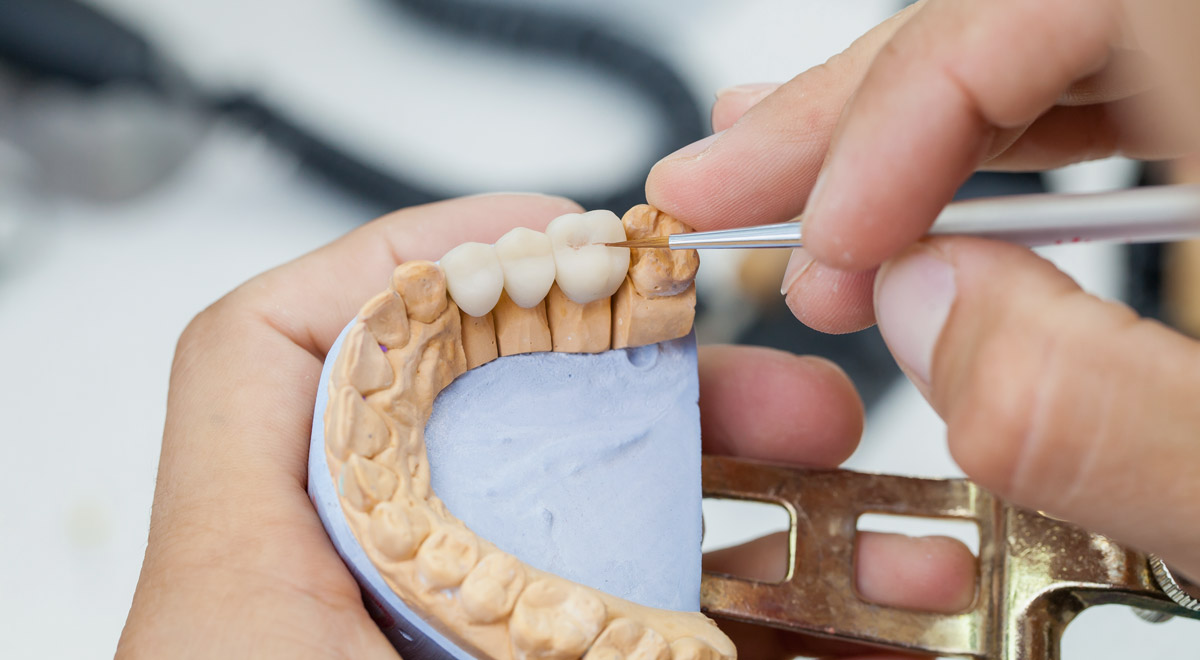Missing teeth can affect much more than just your smile. Tooth loss impacts chewing function, speech, and overall oral health. A dental bridge is a popular and effective way to replace either one tooth or multiple teeth, restoring both function and aesthetics.
In this guide, you will learn everything you need to know about a bridge for the teeth including what it is, the types available, when they are recommended, the dental bridge procedure, caring for a new bridge, and typical costs involved in the UK.
Understanding a dental bridge
A dental bridge is a fixed restoration designed to fill the gap left by one or more missing teeth.
It typically consists of one or more pontics, which are replacement teeth or false teeth, supported by crowns placed on the adjacent natural teeth or dental implants.
These supporting teeth, known as abutment teeth, anchor the bridge securely and help maintain the alignment of the surrounding natural teeth while preventing bone loss at the site of tooth loss.
When a bridge is fitted, it restores chewing function and preserves the overall health of your mouth by preventing the remaining teeth from shifting into the gap created.
A custom bridge is usually crafted by a dental lab to perfectly match the shape and colour of your natural teeth, ensuring a confident smile.
Types of dental bridges
There are several types of dental bridges, each suited to different dental issues and personal preferences.
Traditional dental bridge
Traditional dental bridges are the most common type. They use dental crowns on the teeth on either side of the gap to support one or more pontics. This option works well when you have healthy adjacent teeth capable of supporting the bridge.
Cantilever dental bridge
A cantilever dental bridge is used when there are supporting teeth on only one side of the gap left by the missing tooth or teeth. This type is less common and typically used when the gap is on the side of the jaw where chewing forces are less intense.
Maryland dental bridge (resin-bonded bridges)
Maryland dental bridges, also known as resin-bonded bridges, use a metal or porcelain framework that is bonded to the backs of the surrounding natural teeth. This type is minimally invasive and often recommended to replace a single missing front tooth.
Implant-supported bridges
Implant-supported bridges provide a long-lasting solution when multiple missing teeth need replacing. Rather than relying on abutment teeth, the bridge is fixed to dental implants surgically placed into the jawbone. Implant-supported crowns and two implant-supported crowns are common methods. This approach avoids damage to surrounding teeth and helps prevent bone loss.
When is a dental bridge recommended?
Your dentist may recommend a dental bridge for several reasons, primarily to replace missing teeth and restore oral health. The gap created by missing teeth can cause surrounding teeth to shift, leading to bite issues and tooth decay.
A bridge helps maintain the position of remaining teeth, supporting chewing function and preventing further dental issues such as gum disease.
Dental bridges are suitable for patients who want a permanent solution to tooth loss but may not be candidates for dental implants due to bone loss or other health conditions.
Bridges also serve as an alternative to partial dentures, which are removable appliances that replace multiple missing teeth.
The dental bridge procedure: what to expect
The dental bridge procedure typically involves several steps:
Initial consultation and assessment
Your dentist will examine your oral health, including the condition of the supporting teeth, gums, and bone density. X-rays may be taken to check for tooth decay, gum disease, or bone loss.
Preparation of abutment teeth
The adjacent natural teeth (abutment teeth) on either side of the gap are shaped to fit dental crowns, which will support the bridge. Local anaesthetic is used to ensure comfort during this process.
Impression and temporary bridge
An impression of your teeth is taken and sent to a dental lab to fabricate a custom bridge that fits precisely. Meanwhile, a temporary bridge is placed to protect the gap and surrounding teeth.
Fitting the new bridge
Once the new bridge is ready, your dentist will remove the temporary bridge and fit the custom bridge.
The bridge is adjusted for a comfortable bite and cemented into place. Proper fit is essential for function and to protect the gum line and supporting teeth.
For implant-supported bridges, the procedure includes surgical placement of one implant or multiple implants, followed by a healing period before the bridge is fitted onto implant-supported crowns.
Advantages and disadvantages of dental bridges
Dental bridges offer many benefits. They restore chewing function, improve speech, and help maintain facial structure. They provide a natural look that blends seamlessly with surrounding natural teeth and deliver a long lasting solution to tooth loss.
However, there are potential drawbacks. Traditional bridges require altering healthy natural teeth, which may increase the risk of tooth decay or gum disease if not cared for properly. The supporting teeth may weaken over time, compromising the bridge.
Proper care, including brushing, flossing with floss threaders, and regular dental check-ups, is crucial to prevent these issues.
Caring for your dental bridge
Taking care of your dental bridge is vital for its longevity. You should maintain excellent oral hygiene by brushing twice daily and flossing carefully around the bridge and supporting teeth.
Using floss threaders helps clean underneath the pontics where food debris can collect.
Avoid chewing very hard foods on the bridge to prevent damage. Regular dental visits allow your dentist to monitor the health of your crowns, gums, and surrounding teeth. Addressing dental issues early can prevent the need for bridge replacement.
With proper care, a dental bridge can last anywhere from five to fifteen years. Implant-supported bridges may last even longer.
Costs and private treatment options in the UK
The cost of placing dental bridges varies based on the type of bridge, materials, and complexity. Traditional bridges typically cost between £600 and £1,200 per unit.
Maryland dental bridges and cantilever bridges may be slightly less expensive, but implant-supported bridges are generally more costly due to the surgical element, with prices starting from around £2,000.
Costs are also affected by the number of teeth being replaced. For example, replacing multiple missing teeth requires a larger bridge or multiple implants, which increases the price.
If additional treatments like gum disease management or tooth decay treatment are needed before placing the bridge, this will add to the overall cost.
Discussing your personal preferences and overall health with your dentist will help you choose the best option within your budget. Some clinics offer payment plans to spread the cost over time.
For expert restorative dentistry, come to Fulham Road Dental
At Fulham Road Dental, we specialise in restoring smiles and improving oral health through personalised restorative dentistry treatments. Our experienced team provides tailored solutions to replace missing teeth and restore your smile’s function and appearance.
We understand that each patient’s needs and personal preferences are unique. That is why we offer a comprehensive range of restorative options designed to suit your individual oral health and lifestyle.
From custom bridges crafted in partnership with trusted dental labs to implant-supported crowns that provide a long-lasting solution, we are committed to helping you achieve a natural, healthy smile that feels as good as it looks.
Visit our Fulham dental practice to experience expert care in a modern, welcoming environment where your overall health and well-being are our top priorities. Let us help you restore your chewing function, protect your surrounding natural teeth, and regain a confident smile you can be proud of.
Your journey to better oral health starts here at Fulham Road Dental!



